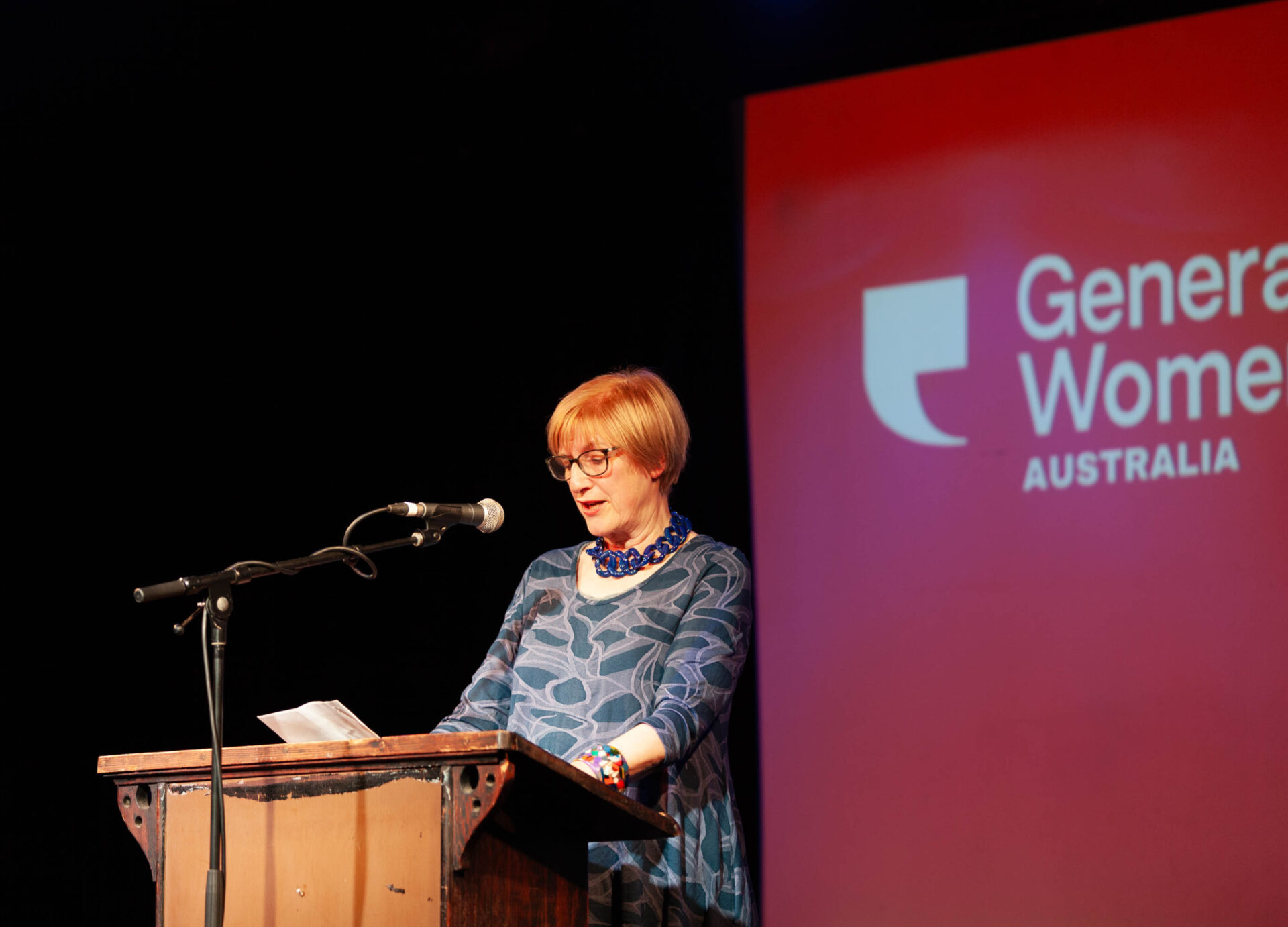
“Go Where the Boss Tells You Not to Go”: Reflections on the Night John Lennon Died
The voices of women, girls and non-binary folk have often been silenced when it comes to history, politics, science, art… well, you name it. But multigenerational storytelling night, Generation Women, is speaking truth to power, offering a warm and inclusive space where people of all ages can come together to share, celebrate and learn.
Held in Sydney and Melbourne, the monthly event aims to amplify a selection of female and non-binary voices – representing those in their twenties through to their seventies (and beyond) – each sharing their own stories on a specific theme.
above GENERATION WOMEN MELBOURNE AUGUST PERFORMERS. PHOTO BY SEVIM DOGAN OZKAN
Peppermint is proud to partner with the Generation Women team to bring you a monthly series sharing the words and wisdom from some of the storytellers. August’s theme was ‘Desperate Times, Desperate Measures: Stories of Drastic Action’, with performers like acclaimed journalist and writer Jane Sullivan sharing a time when the going got tough, so the tough got going.
For more information about Generation Women, including forthcoming events, head to their website here.
above JANE SULLIVAN SPEAKING AT GENERATION WOMEN MELBOURNE: DESPERATE TIMES, DESPERATE MEASURES! PHOTO BY SEVIM DOGAN OZKAN
Melbourne Storyteller Team 70s: Jane Sullivan
Let me take you back in time to 8 December 1980, before some of you were born. I’m 30 years old and I’m a reporter for The Age. It’s nearly midnight and I’m asleep in a New York hotel room after a busy few days. I’ve come to New York to interview an art expert for an investigative story one of my colleagues is working on. It was a good interview: the art expert was incandescent with rage about the distinct possibility that fraudulent artworks had been donated to the National Gallery of Victoria.
A ringing phone pierces my dreams. It’s the news editor in the Melbourne office. “John Lennon has been shot,” he says. “We want you to do a story for news.” Sure, I say, still half asleep. What should I do? “Don’t go to the Dakota building,” he says. “Go to the AP office, you can get the story there.”
Get the story. That’s the mantra we live by, that drives us, that and the even more potent fear of what might happen if we don’t get the story. So I don’t even think or feel anything about this terrible news. I’m on autopilot, stumbling into my clothes, shoving my notebook and pen into my bag, running down to the front desk where the night staff calls me a cab. I’ve no idea where The Associated Press news agency is, but the cabbie knows. I flash my press pass at the security guard and wonder of wonders, he lets me in. The office is almost deserted, but machines are humming, and ticker tape and faxes are pouring out, full of the latest news. I tear off a strip and hastily rewrite the story in my own words. The gist of it is that John Lennon was shot at the entrance to the Dakota Building, where he lived, and taken to hospital, where he died from bullet wounds.
I grab a phone and call up The Age copytakers on the other side of the world. These were a group of nice efficient ladies who in those pre-internet days would take a reporter’s dictation down the line and type it out for the news desk. Well, that’s done. Still some time before the next edition deadline. Perhaps I can get something else?
I remember the news editor’s strange words: “Don’t go to the Dakota building”. You know when someone says, “Don’t think about pink elephants” and suddenly that’s all you can think of? So off I go again. It’s two in the morning but in the city that never sleeps, you can still get a cab.
Outside there are hundreds, perhaps thousands, of men and women. All young, no-one older than me. Some are children in pyjamas. They are holding up candles, torches and cigarette lighters, so the pavement and road are studded with little stars.
The Dakota building is dark, vast and Gothic, the sort of place Count Dracula might stay in if he visited New York. And outside there are hundreds, perhaps thousands, of men and women. All young, no one older than me. Some are children in pyjamas. They are holding up candles, torches and cigarette lighters, so the pavement and road are studded with little stars.
There’s a makeshift fence and the cops are keeping people away from the entrance, but there’s no scuffle, no attempt at invasion. They just stand there, mostly silent, but there’s music too. Some people have tape recorders playing Beatles songs. Others play the well-known tunes on guitars and their friends sing along, many with tears streaming down their cheeks. “Hey Jude…” I’ve never seen anything like it. They are a generation saying goodbye to a hero who belongs to them. He belongs to me too.
I walk up and down the lines, take note of what people are singing and saying, scribble feverishly in my notebook. This is the story. This is the kind of vivid descriptive on-the-spot stuff The Age hired me to write. Today I can’t remember exactly who I talked to or what they said. It was the collective impact of all these hundreds of mourners I remember best. I walk on, scribble on, until the pressure of deadline means I can’t stay any longer. Have to get back to the phone in my hotel room. I walk away from the crowd, into the street. Suddenly it’s very dark and lonely and I remember all the warnings not to go out alone in the city streets at night. Where’s a cab when I need one?
They are a generation saying goodbye to a hero who belongs to them. He belongs to me too.
At last, one pulls up and I get in. Another passenger, a man, is already sitting in the back seat. Is this a New York thing, do cabbies share rides? It seems so. We head off towards the hotel. My companion seems up for a late-night chat. He smells of beer. He wants to know what I’ve been doing and I tell him a little about it. He shakes his head. “How about that?” He sits a little closer. When we get to the hotel he asks me if I’d like to go for a drink with him. A drink? It’s 5.30 in the morning. I scramble out of the car as quickly as I can, shove dollars at the cabbie and run into the hotel. Thank God, that man hasn’t followed me. Now for another call to the copytakers and then at last I can sleep.
READ MORE: “I Aspired Not to Be Ladylike – But to Be Humane”: Stories of Unladylike Behaviour
The next night I’m on a Qantas flight back to Melbourne. They have the latest copies of The Age on the plane and I feel a rush of adrenalin when I see that my news story is across the top of the front page, with my byline. But where’s my story on the people at the Dakota? I riffle through the pages, but can’t find it. I go back to the front page and hey, here’s a story with a big fat headline further down the page, all about exactly the same scenes I witnessed. But I didn’t write it. It’s by another Age colleague of mine, who must have been in New York on holiday. I had no idea, I didn’t see him there. I feel a surge of anger, how dare he invade my patch?
I have to say it’s a very good story. He’s interviewed one of those classic New York cops who was at the scene, gets his gravelly Brooklyn voice, all choked up, and describes his tearstained face. Lennon was his hero too. What do you know, I’ve been scooped by my own paper. And suddenly I feel ashamed of my news story, cobbled together as it is from AP copy. It’s victory of a sort, but the victory feels hollow.
When you’re on a desperate dash to get the story, you feel numb. All you think of is the job. Later, I reflect. About what John Lennon meant to me. About how I grew up with The Beatles, fell in love with them, bought their albums, covered my bedroom wall with pictures of John, Paul, George and Ringo and kissed each one goodnight. How later on, John in particular came to stand for my generation’s refusal to go along with all the old ideas. He was a complicated hero but we love him still.
I’m also reflecting now on one curious thing. The news editor, a man, told me not to go get a story at the Dakota building because, unknown to me, he’d already assigned it to another reporter, a man. The investigative reporter, a man, I was helping out with my interview with the art dealer, a man. The security guard at the AP building, a man. The cops at the Dakota, all men. The three cabbies, all men. The passenger in the back seat, a man. The hero we loved and lost, a man. The person who shot him, a man.
The media world is very different today. I hope and trust it’s a better place for women.
No, it wasn’t a patriarchal conspiracy. It was just the way the world was back then. I was the odd one out. I was always fighting so hard to get the story, to show that a woman could do it just as well, maybe better. But it was men who had the power, who gave me opportunities, or who withheld them. I was kind of helping out.
The media world is very different today. I hope and trust it’s a better place for women. I’ve had a good career and I’m grateful to the men and women who gave me my opportunities. I’m still writing freelance and I’ve now turned to writing fiction, where I can explore the world more deeply than I could in the daily news cycle.
To you young women journalists out there, I say, go get the story. What’s the story? Whatever you think it is. Don’t be scared, don’t be ashamed. Go where the boss tells you not to go. Your way of seeing the world matters: “You may say I’m a dreamer, but I’m not the only one.”



